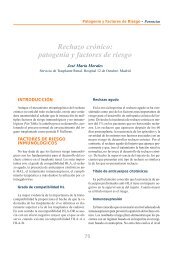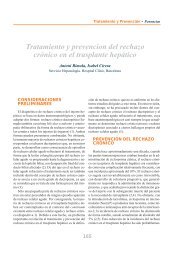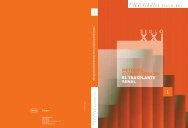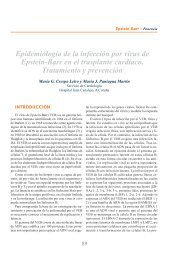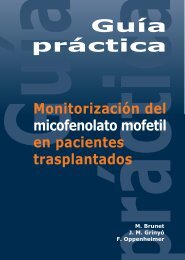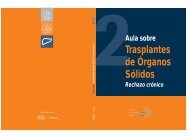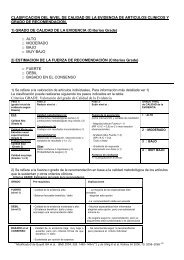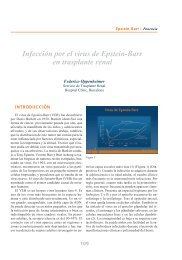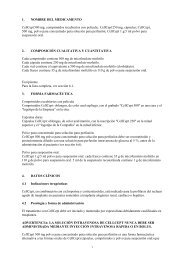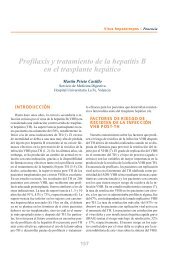Untitled - Roche Trasplantes
Untitled - Roche Trasplantes
Untitled - Roche Trasplantes
You also want an ePaper? Increase the reach of your titles
YUMPU automatically turns print PDFs into web optimized ePapers that Google loves.
BIOPSIA DE PROTOCOLO EN EL TRASPLANTE RENAL<br />
decreases the concentration of pre-existing and post-transplantation antibodies. Recently,<br />
results from a single center study were published indicating that multiple plasmapheresis<br />
treatments leads to more reproducible desensitization and lower humoral rejection<br />
rates than a single high-dose of IVIG. In this study, comprising 61 patients, three different<br />
treatment regimens were compared: plasmapheresis + low-dose IVIG + anti-CD20-<br />
antibody versus high-dose IVIG versus plasmapheresis + low-dose IVIG + anti-CD20-antibody<br />
+ pre-transplant thymoglobulin. However, none of these three therapeutical regimens<br />
was completely effective in preventing humoral rejection in renal allograft recipients<br />
with high levels of donor specific alloantibodies.<br />
Prospective treatment guidelines can not be drawn from these small studies yet, since<br />
rituximab is usually combined with other drugs and therapies in these uncontrolled trials.<br />
However, plasma cells, the physiological source of antibodies do express little or<br />
no CD20 and are therefore resistant to rituximab mediated depletion. Plasma cells express<br />
various cell surface molecules (CD138, CD38, alpha4-beta1-integrin, CXCR4) which<br />
are however all not entirely plasma-cell specific. In mouse models treatment with anti<br />
TACI immunoglobulin (=transmembrane activator and calcium-modulating cyclophilinligand<br />
interactor), which is expressed by B cells and plasma cells as a member of TNFreceptor<br />
family, depleted long-living plasma cells. TACI-immunoglobulin is already in<br />
Phase I clinical trials for treatment of systemic lupus erythemathodes and B-cell lymphomas<br />
with signs of plasma cellular maturation. This approach might lead to more specific<br />
and more effective plasma cell depletion than currently achieved by thymoglobulins<br />
alone.<br />
Future strategies might be directed towards a highly specific complement blockade by<br />
complement receptor antagonists like C5a receptor inhibitors. Antagonizing activation of<br />
complement component C5 leads to blockade of C5a and MAC formation and herewith<br />
should prevent complement mediated cell damage. First candidate compounds are in<br />
preliminary stages of evaluation for clinical use.<br />
CONCLUSIONS<br />
Humoral rejection is beside cellular rejection a relevant pathogenetic factor for acute and<br />
chronic immunologic allograft damage. Under modern, mainly T cell targeted immunosuppression<br />
and as a consequent of an increasing number of patients with repetitive<br />
transplantations alloantibodies will become a major obstacle to short- and long-term allograft<br />
survival.<br />
For the detailed understanding of the ambivalent potential of alloantibodies (rejection versus<br />
accommodation) more insights into the regulation of B cells and the development<br />
and differentiation pathways of memory B cells and plasma cells are desperately needed.<br />
This can be the basis for developing methods to promote accommodation and to pre-<br />
66




